There is something so calming and nostalgic about preparing a fire in the fireplace. There is something so inviting and comforting about sitting near a crackling fire on a cold winter night.
It’s very simple to prepare a fire in the fireplace, and it costs nothing since we don’t use any electricity. It is all about gathering up some wood, stacking it up and lighting it with matches or lighter fluid.
Most people think that they need to buy special equipment to start a fire but this isn’t the case at all. It really doesn’t take much time or effort at all to prepare a fire in the fireplace, which is why I love doing it!
A fire not only tells us the time of day, but it also gives us a sense of safety and warmth. And it doesn’t stop there. It can also be a calming background noise and an opportunity to unwind and enjoy nature’s beauty. Here’s a guide on how to stack wood in your fireplace.
Contents
- Steps to Stack Wood in a Fireplace
- Step 1. Gather All the Supplies You Need to Build a Fire
- Step 2: Prepare the Fireplace
- Step 3: Layering woods in a Fireplace and Lighting the Kindling.
- How to Stack Wood in a Traditional Fireplace
- How to Stack Wood in a Top-Down Fireplace Fire
- More benefits of a Top-Down Method
- How to Stack Wood in the “Log Cabin” Method
- Summary
- Things to remember Before Stacking Wood in a Fireplace
Steps to Stack Wood in a Fireplace
Step 1. Gather All the Supplies You Need to Build a Fire
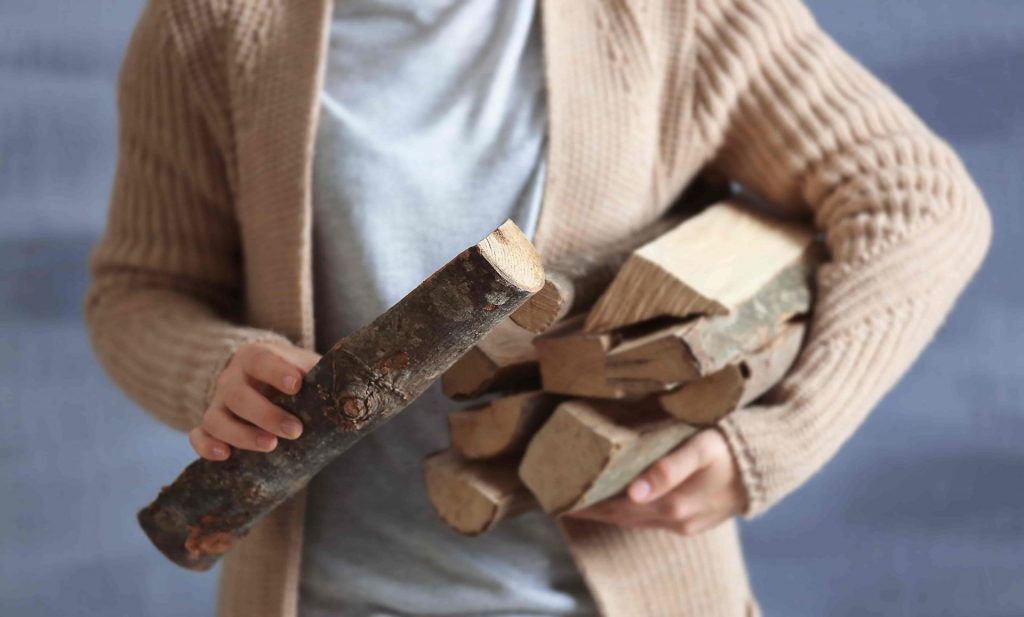
When building a fire it is essential to ensure you gather all the supplies to make the process quick and straightforward without struggling and moving around a lot. Here is what you need before building a fire:
- Dry wood or well-seasoned wood
- Kindling for starting a fire. These are scraps of small woods from log splits or foraged twigs from the yard. You can DIY kindling by splitting logs into small pieces.
- Uncoated sheets of newspaper
- Extra-long wooden strike matches to prevent you from burning or singeing your fingers.
- Metal Grate for maximum airflow under the burning logs and prevent them from falling out of the fireplace.
- A metal ash bucket with a tight-fitting lid for collecting ashes.
- Fireplace utensils like poker, tongs, brush, and shovel.
- Screen to cover the width of the hearth’s openings.
- A Moisture Meter to help you to accurately read the moisture content of your wood. Use a block of wood with a moisture content of 20% or lower because it burns much better than wood with a moisture content higher than 20%.
Whether you purchase a cord, face cord or rick of firewood– you need to know how to stack your firewood for your fires to burn best!
Step 2: Prepare the Fireplace
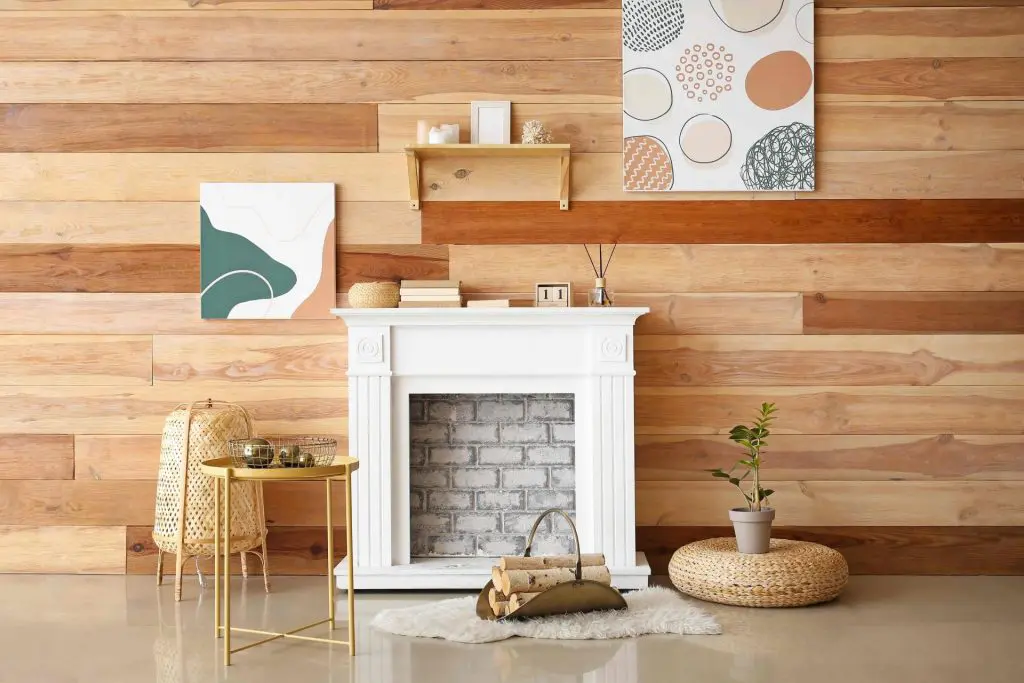
With all the tools in place, start preparing the fireplace by inspecting the chimney to check creosote build-up in the flue and removing excess ashes. Creosote is tar from the burning wood. Creosote prevents gases and smoke from leaving the chimney while ashes reduce the effectiveness of airflow under the burning log. Therefore, clean the chimney and remove excess ash. However, you should leave a small amount of ash at the base of the grate or fireplace for insulation purposes when starting a fire.
Ensure all flammable materials or products such as petroleum products, lotion, drapes, clothes, coated assets, home décor are far away from the fireplace. Further, ensure nothing is hanging off the fireplace and no item is at a proximity of 4-5 feet from the fireplace.
Lastly, don’t forget to prime the Chimney to get the fire going more quickly without going out or with minimal smoke being produced. To prime, the chimney is simply warming up the air inside the chimney by lighting a piece of newspaper. Warming up the chimney before setting fire helps to drive out cold air from the chimney to establish a strong draft. Or, helps to pull waste smoke and gases out of the fireplace more quickly, and in turn feeds the fire with more oxygen from the room. Remember to childproof your fireplace before you light it up!
Step 3: Layering woods in a Fireplace and Lighting the Kindling.
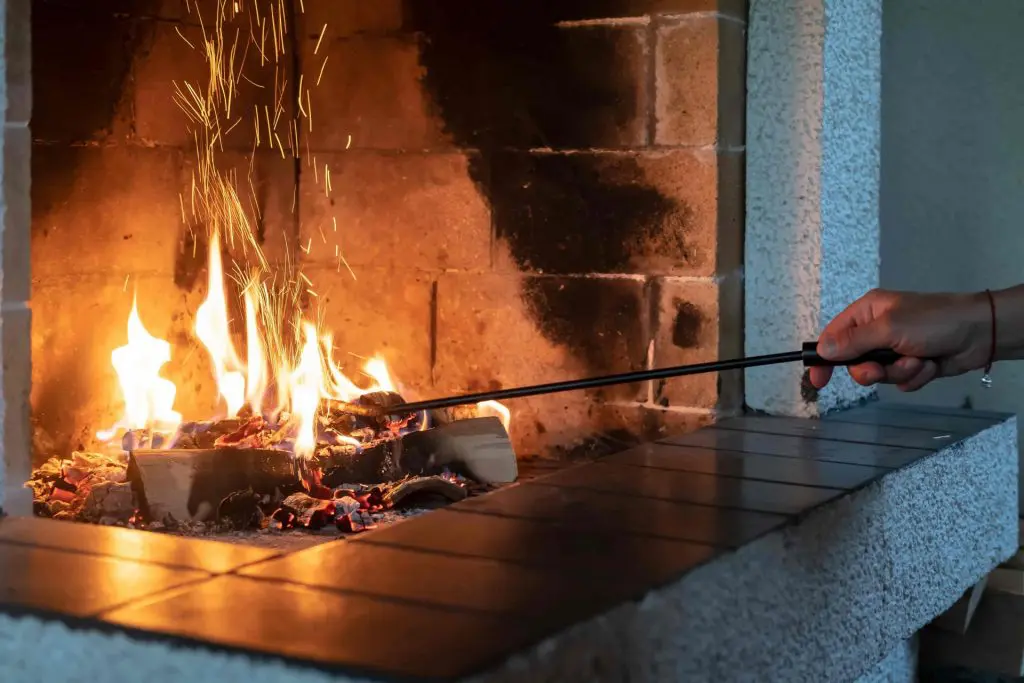
Once you are done with preparing the fireplace, you may use any method below to stack wood in the fireplace and start a fire. We recommend you strictly adhere to the guide below if you intend to generate a comforting degree of heat with minimum care and attention. If this is all too messy for you, consider investing in a gas, tabletop, ethanol, or even a faux fireplace!
How to Stack Wood in a Traditional Fireplace
This is the typical or the most common method of stacking wood and building a fire in a fireplace. Nevertheless, it is also a straightforward method than others by simply placing newspaper at the base of the fireplace, then adding kindling and logs on top. Well, it is simple, but you need to employ some tricks for the log to burn efficiently, bigger, and produce an excellent degree of heat without much smoke. To arrange the wood in the Tradition method consider the steps below;
- Place sheets of newspaper either under the grate or at the base of the grate. Placing newspaper is better than under the grate because if you start a fire the kindling and logs won’t move after they have started burning.
- Arrange the kindling by crisscrossing while interconnected in a manner for the flame and heat to spread each. Ensure you live enough space between each other to allow air to flow through sufficiently to enhance efficient kindling combustion. Avoid stacking kindling together or packing them too closely, but far apart enough for the heat and flame to create turbulence of air around the logs and keep the air flowing through.
- After arranging the kindling as suggested above, stack logs on kindling while following the same procedure. Arrange the logs depending on the size of your fireplace and the size of the fire you intend to build, but not as many as kindling. We recommend you use smaller logs in this method because they catch fire more quickly and allow you to stack many more logs than larger-sized logs.
- Go ahead and light the newspaper at the bottom of the fireplace.
- When the log is about to burn through, add one or two logs at a time on the fire, but not too far away from each other.
How to Stack Wood in a Top-Down Fireplace Fire
Unlike conventional, the top-down fire method is much beneficial, cleaner, and burns brighter. In fact, the method of wood arrangement is opposite or in the reverse order to the traditional method. Instead, the logs are arranged upside down by stacking larger-sized logs at the base followed by the medium, then kindling and newspaper at the top. However, it is not as simple as you might have perceived from the explanation above. To understand the method follow the steps below:
- Take the larger-sized logs to arrange them tightly and closer in a horizontal position at the base for flame or fire to easily transfer or spread between the logs.
- Add another layer on top of the first layer consisting of medium-sized logs while arranging them horizontally, but in a perpendicular direction to the layer at the bottom. The significance of arranging the logs facing in opposite directions helps to create sufficient airflow through the logs despite being tightly packed together.
- Then form the final pattern by arranging the kindling at a 90-degree angle in a crisscrossing pattern like in the convectional method. Use small-sized logs as kindling and they should not take up more than half of the height of your fireplace.
- Add sheets of newspaper to the top of the stack of kindling.
- Light the newspaper from the top, sit back, and watch as they burn downwards through the kindling to the base.
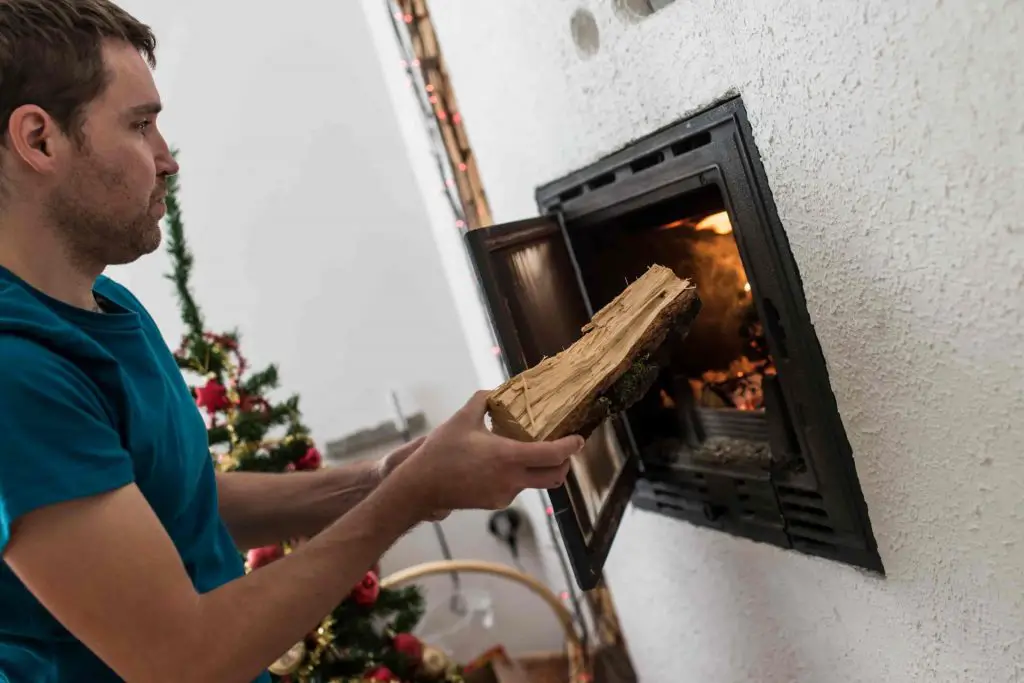
The top-down method allows you can add larger-sized logs from the top right from the start because the fire burns from top to down with more heat and flame spreading in all directions. Therefore, it can burn for a longer period without needing much attention and adding logs. Since the fire is burning from the top, it also generates a freely, efficient, and cleaner burning flame with less smoke due to plenty of air coming from the base and in all directions. Nevertheless, lighting the fire from the top primes the chimney which helps to pull waste smoke and gases out of the fireplace more quickly, and in turn, feeds the fire with more oxygen from the room. The only disadvantage with this method is that it is time-consuming compared to the traditional method.
More benefits of a Top-Down Method
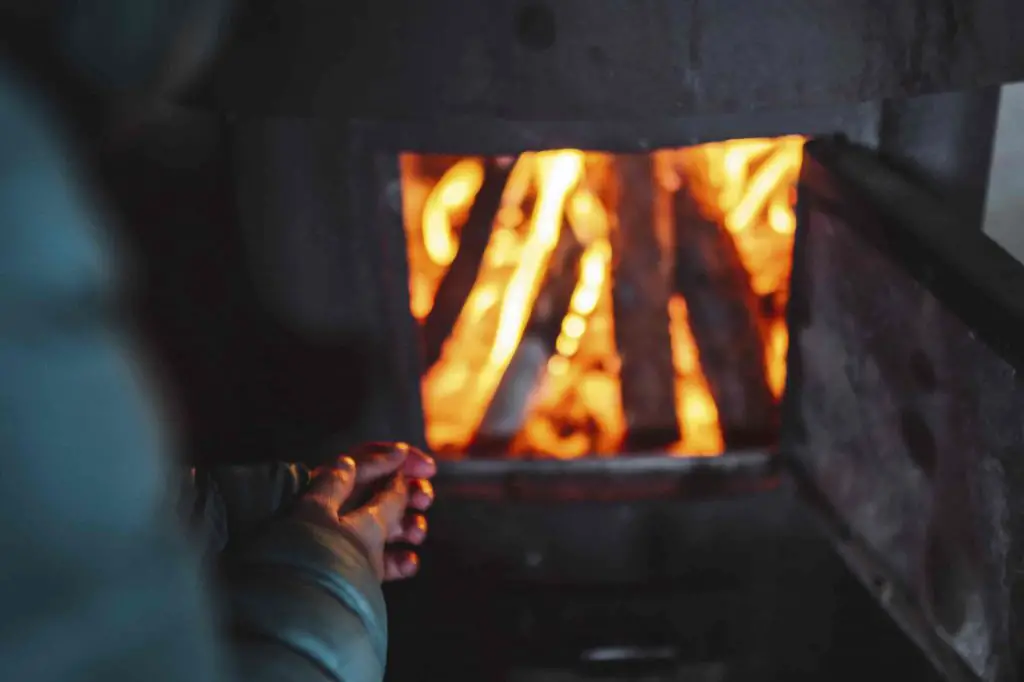
- Since the logs are tightly packed, it is hard for them to move and collapse on themselves.
- Lighting the fire from the top helps to warm the chimney thereby eliminating troubleshooting that can cause fire to go out easily.
- Requires little attention and maintenance after lighting the fire.
- Produces more heat with less ash.
How to Stack Wood in the “Log Cabin” Method
Comparing this method to the other, it produces maximum heat production and is also the easiest method, but essential if it warms up the Chimney. To successfully stack wood in the “Log Cabin” method follow these steps. They include;
- Start by laying kindling in the middle.
- Place two thin logs without barks parallel to the back of the fireplace, about six inches apart from one another.
- Pack sheets of newspaper in between the two pieces of firewood and cover with kindling.
- Place one to two more pieces of logs not necessarily 6” away, but arrange them perpendicularly to the top of the base layer and sure there is enough space for ventilation.
- You may choose to add more layers while the logs running in the same direction as the first pair.
- Twisting a single sheet of newspaper and light it while holding it as high up above in the fireplace to establish a good draft in the chimney as the heat rises.
- Slowly light the kindling with the burning paper.
- Once you have established a fire, add more logs if needed and make sure to keep flames visible below the fireplace opening.
Summary
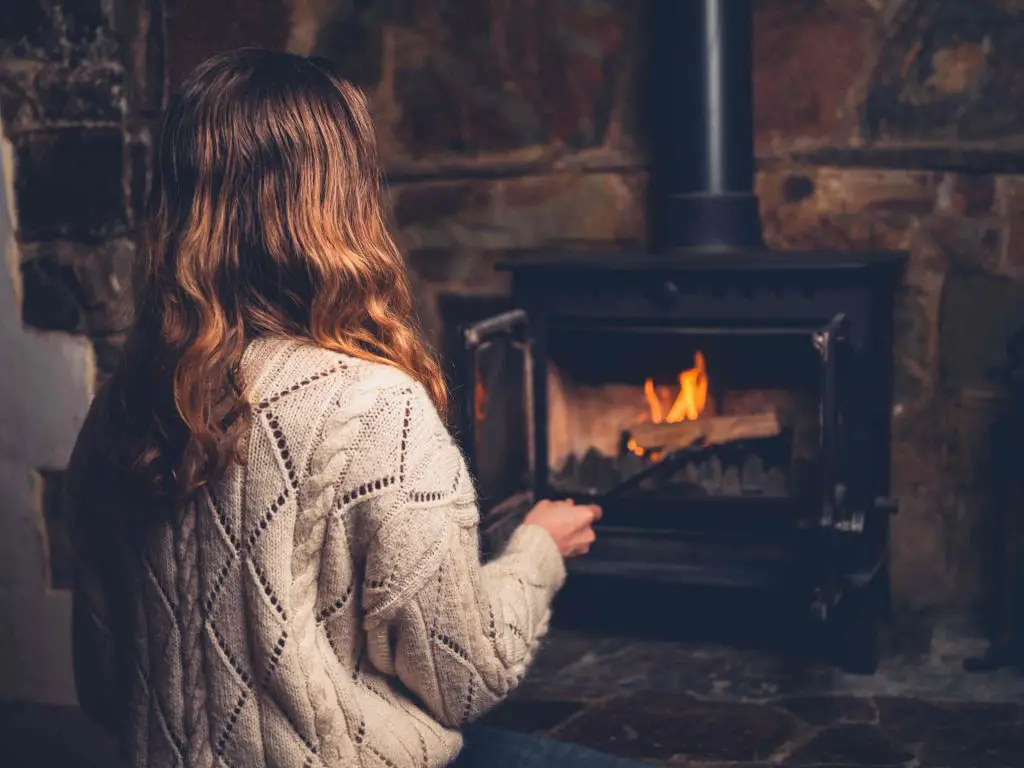
We all need to keep ourselves warm on a cold winter night, but do you know how to stack wood in a fireplace? Okay, it may be an easy task for those living in places experiencing extreme cold temperature conditions all around the year; however. It may be a hard task for beginners or individuals living in places experiencing the winter season once a year. Well, you have landed on the right article, because we will help you on how to stack wood in a fireplace and watch it burn without constantly poking at the logs.
Things to remember Before Stacking Wood in a Fireplace
- Only burn dry wood with a moisture content of 20% or lower.
- Always bring in the wood before each fire
- Ensure that the damper Is fully open before each fire to prevent the loss of air from your home when the fireplace isn’t being used.
- Warming up the air inside the chimney to ensure that there is sufficient draft before starting a fire.
- For effective burning, don’t pack logs too tightly together for efficient airflow and to enhance the flames to spread to other logs.
- If you want increased heat output and duration we strongly recommend you use hardwood logs rather than softwoods.
